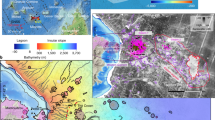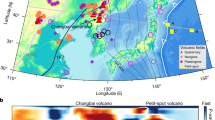Abstract
Volcanism that occurs far from plate margins is difficult to explain with the current paradigm of plate tectonics. The Changbaishan volcanic complex, located on the border between China and North Korea, lies approximately 1,300 km away from the Japan Trench subduction zone and is unlikely to result from a mantle plume rising from a thermal boundary layer at the base of the mantle. Here we use seismic images and three-dimensional waveform modelling results obtained from the NECESSArray experiment to identify a slow, continuous seismic anomaly in the mantle beneath Changbaishan. The anomaly extends from just below 660 km depth to the surface beneath Changbaishan and occurs within a gap in the stagnant subducted Pacific Plate. We propose that the anomaly represents hot and buoyant sub-lithospheric mantle that has been entrained beneath the sinking lithosphere of the Pacific Plate and is now escaping through a gap in the subducting slab. We suggest that this subduction-induced upwelling process produces decompression melting that feeds the Changbaishan volcanoes. Subduction-induced upwelling may also explain back-arc volcanism observed at other subduction zones.
This is a preview of subscription content, access via your institution
Access options
Subscribe to this journal
Receive 12 print issues and online access
$259.00 per year
only $21.58 per issue
Buy this article
- Purchase on Springer Link
- Instant access to full article PDF
Prices may be subject to local taxes which are calculated during checkout





Similar content being viewed by others
References
Wei, H. et al. Three active volcanoes in China and their hazards. J. Asian Earth Sci. 21, 515–526 (2003).
Montelli, R. et al. Finite-frequency tomography reveals a variety of plumes in the mantle. Science 303, 338–343 (2004).
Zou, H., Fan, Q. & Yao, Y. U–Th systematics of dispersed young volcanoes in NE China: Asthenosphere upwelling caused by piling up and upward thickening of stagnant Pacific slab. Chem. Geol. 255, 134–142 (2008).
Zhao, D., Tian, Y., Lei, J., Liu, L. & Zheng, S. Seismic image and origin of the Changbai intraplate volcano in East Asia: Role of big mantle wedge above the stagnant Pacific slab. Phys. Earth Planet. Inter. 173, 197–206 (2009).
Xu, Y-G., Zhang, H-H., Qiu, H-N., Ge, W-C. & Wu, F-Y. Oceanic crust components in continental basalts from Shuangliao, Northeast China: Derived from the mantle transition zone? Chem. Geol. 328, 168–184 (2012).
Tatsumi, Y., Maruyama, S. & Nohda, S. Mechanism of backarc opening in the Japan Sea: Role of asthenospheric injection. Tectonophysics 181, 299–306 (1990).
Fukao, Y., Obayashi, M., Nakakuki, T. & Group, D. S. P. Stagnant slab: A review. Annu. Rev. Earth Planet. Sci. 37, 19–46 (2009).
Li, C. & van der Hilst, R.D. Structure of the upper mantle and transition zone beneath Southeast Asia from traveltime tomography. J. Geophys. Res. 115, B07308 (2010).
Kuritani, T., Ohtani, E. & Kimura, J-I. Intensive hydration of the mantle transition zone beneath China caused by ancient slab stagnation. Nature Geosci. 4, 713–716 (2011).
Chen, Y., Zhang, Y., Graham, D., Su, S. & Deng, J. Geochemistry of Cenozoic basalts and mantle xenoliths in Northeast China. Lithos 96, 108–126 (2007).
Faccenna, C. et al. Subduction-triggered magmatic pulses: A new class of plumes? Earth Planet. Sci. Lett. 299, 54–68 (2010).
Tromp, J., Tape, C. & Liu, Q-Y. Seismic tomography, adjoint methods, time reversal and banana-doughnut kernels. Geophys. J. Int. 160, 195–216 (2005).
Ito, E. & Takahashi, E. Postspinel transformations in the system Mg2SiO4-Fe2SiO4 and some geophysical implications. J. Geophys. Res. 94, 10637–10646 (1989).
Hirose, K. Phase transitions in pyrolitic mantle around 670-km depth: Implications for upwelling of plumes from the lower mantle. J. Geophys. Res. 107, 2078 (2002).
Fei, Y. et al. Experimentally determined postspinel transformation boundary in Mg2SiO4 using MgO as an internal pressure standard and its geophysical implications. J. Geophys. Res. 109, B02305 (2004).
Litasov, K. D., Ohtani, E. & Sano, A. Influence of Water on Major Phase Transitions in the Earth’s Mantle. in In Earth’s Deep Water Cycle (eds Jacobsen, S.D. & van der Lee, S) 95–111 Vol 168 (Geophys. Monogr. Ser. AGU, 2006).
Stixrude, L. & Lithgow-Bertelloni, C. Geophysics of chemical heterogeneity in the mantle. Annu. Rev. Earth Planet. Sci. 40, 569–595 (2012).
Kawakatsu, H. & Yoshioka, S. Metastable olivine wedge and deep dry cold slab beneath southwest Japan. Earth Planet. Sci. Lett. 303, 1–10 (2011).
Kubo, T., Kaneshima, S., Torii, Y. & Yoshioka, S. Seismological and experimental constraints on metastable phase transformations and rheology of the Mariana slab. Earth Planet. Sci. Lett. 287, 12–23 (2009).
Obayashi, M., Sugioka, H., Yoshimitsu, J. & Fukao, Y. High temperature anomalies oceanward of subducting slabs at the 410-km discontinuity. Earth Planet. Sci. Lett. 243, 149–158 (2006).
Bagley, B., Courtier, A. M. & Revenaugh, J. Melting in the deep upper mantle oceanward of the Honshu slab. Phys. Earth Planet. Inter. 175, 137–144 (2009).
Honda, S., Morishige, M. & Orihashi, Y. Sinking hot anomaly trapped at the 410 km discontinuity near the Honshu subduction zone, Japan. Earth Planet. Sci. Lett. 261, 565–577 (2007).
Morishige, M., Honda, S. & Yoshida, M. Possibility of hot anomaly in the sub-slab mantle as an origin of low seismic velocity anomaly under the subducting Pacific plate. Phys. Earth Planet. Inter. 183, 353–365 (2010).
Kawakatsu, H. et al. Seismic evidence for sharp lithosphere–asthenosphere boundaries of oceanic plates. Science 324, 499–502 (2009).
Hirano, N. Petit-spot volcanism: A new type of volcanic zone discovered near a trench. Geochem. J. 45, 157–167 (2011).
Song, T-R.A. & Kawakatsu, H. Subduction of oceanic asthenosphere: Evidence from sub-slab seismic anisotropy. Geophys. Res. Lett. 39, L17301 (2012).
Hofmann, A. W. Mantle geochemistry: The message from oceanic volcanism. Nature 385, 219–229 (1998).
Machida, S., Hirano, N. & Kimura, J. I. Evidence for recycled plate material in Pacific upper mantle unrelated to plumes. Geochim. Cosmochim. Acta 73, 3028–3037 (2009).
Korenaga, J. Mantle mixing and continental breakup magmatism. Earth Planet. Sci. Lett. 218, 463–473 (2004).
Pysklywec, R. N. & Ishii, M. Time dependent subduction dynamics driven by the instability of stagnant slabs in the transition zone. Phys. Earth Planet. Inter. 149, 115–132 (2005).
James, D. E., Fouch, M. J., Carlson, R. W. & Roth, J. B. Slab fragmentation, edge flow and the origin of the Yellowstone hotspot track. Earth Planet. Sci. Lett. 311, 124–135 (2011).
Liu, L. & Stegman, D. R. Origin of Columbia River flood basalt controlled by propagating rupture of the Farallon slab. Nature 482, 386–390 (2012).
Acknowledgements
We thank all the people in the NECESSArray project for installing and servicing the seismic array. Discussions with H. Zou and A. Forte were helpful in preparing the manuscript. The NECESSArray project was supported by NSF and JSPS.
Author information
Authors and Affiliations
Contributions
Y.T. conducted the S-wave tomography and three-dimensional waveform modelling; M.O. conducted the P-wave tomography; F.N. conducted the receiver-function analysis; S.P.G. took the lead in writing the manuscript. All of the authors contributed to the data acquisition and interpretation.
Corresponding author
Ethics declarations
Competing interests
The authors declare no competing financial interests.
Supplementary information
Supplementary Information
Supplementary Information (PDF 2900 kb)
Rights and permissions
About this article
Cite this article
Tang, Y., Obayashi, M., Niu, F. et al. Changbaishan volcanism in northeast China linked to subduction-induced mantle upwelling. Nature Geosci 7, 470–475 (2014). https://doi.org/10.1038/ngeo2166
Received:
Accepted:
Published:
Issue Date:
DOI: https://doi.org/10.1038/ngeo2166
This article is cited by
-
A two-step multi-frequency receiver function inversion method for shallow crustal S-wave velocity structure and its application across the basin-mountain range belts in Northeast China
Science China Earth Sciences (2024)
-
Ultra-low-velocity anomaly inside the Pacific Slab near the 410-km discontinuity
Communications Earth & Environment (2023)
-
High-resolution Moho depth and Vp/Vs ratio distributions in northeast China from joint inversion of receiver functions and gravity data and their geological implications
Science China Earth Sciences (2023)
-
Intraplate volcanism originating from upwelling hydrous mantle transition zone
Nature (2020)
-
Distinct slab interfaces imaged within the mantle transition zone
Nature Geoscience (2020)



